


 |
May 25, 2017: Potsdam and a Spree River Cruise |
 |
May 23, 2017: A Day on Museum Island |
 |
Return to the Index for Our Visit to Berlin |
Today, Karl as booked us all on a day trip to Dresden, Germany. We will be on a tour, which will involve a bus ride south from Berlin, a guided tour of Dresden, some private time when we can wander around on our own, and a return bus trip to Berlin. We have heard a lot about Dresden, and what happened to it during World War II, so we are anxious to see what has been saved and what has been reconstructed.
Getting to Dresden, Germany
We had to wait around for just a while while everyone on the tour arrived, but when they had, we followed our tour guides a half block away to where the motor coach was parked. I jumped on early and grabbed six good seats for us, and just after nine-thirty the bus pulled away.
|
We took some pictures along the way, but there is nothing particularly interesting about farms and fields, but just to record what the countryside looked like, here are a picture and a movie:
|
|
Our motor coach was heading for a stop on the south side of the Elbe River in the middle of historic Dresden. Of course, since we were coming in from the north, we had to cross the Elbe at some point. We turned off the autobahn and onto another major road heading south towards the city. At that point, we got our first look at an oddity here in the German countryside.
|
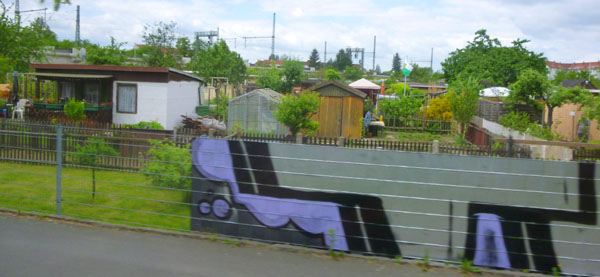
Our tour guide had obviously gotten questions about them before, so he explained without prompting. After reunification, many former country dwellers moved into the new highrises that were being built. Not used to the close quarters, kids started getting sick, and there were other effects as well. The government decided to take any unused land, such as highway right-of-way and allow these new city dwellers to occupy small plots. The only requirement, other than that they could not live their permanently, was that they had to build some small structure and create gardens- either vegetable or decorative- and spend a certain minimum amount of time in the little houses working on the gardens. At a stroke, this seemed to solve the sickness problem, as country dwellers could find an outlet for their "ruralness". But it also beautified the landscape (neat houses and gardens rather than weed-infested vacant land), reduced the need for highway maintenance of these rights-of-way, and offered an economic benefit in the increased production of foodstuffs and other plants- even though the production scale was small.
After we turned off the autobahn, we were driving south through the outskirts of Dresden and then across the Elbe. We took lots of shots from the coach, but here are two representative views of the suburbs of Dresden:
|
|
Most of the pictures we took on the way into the city were like those above; when we got into the central district around the Elbe we passed more historic or notable sites (some of which we would visit later).
|
The statue, showing the Elector of Saxony and King of Poland dressed as a Roman Emperor, stands at the Hauptstrasse, the main pedestrian boulevard in Dresden's Neustadt district, just across the Augustusbridge from the Schlossplatz.
Augustus the Strong was responsible for several of the city's famous baroque buildings, including the Zwinger. During his reign Dresden became an important cultural center, nicknamed "Florence at the Elbe". When he died in 1733 his son Augustus III decided to erect a gilded equestrian statue in honor of his illustrious father.
The statue was designed by the French court sculptor Jean Joseph Vinanche and cast in 1734 by Ludwig Wiedemann, a smith from Augsburg. The following year the gilded statue was unveiled at Neustadt, near the Augustusbridge. The large pedestal was completed much later, in 1884.
The Goldener Reiter escaped unscathed from the allied bombardments of Dresden in February 1945 as it had been dismantled and stored in an underground cave in Pillnitz in 1944. After a restoration that took three years, the landmark statue was erected again at Neustadt just in time for the 750th anniversary of Dresden in 1956.
As we approached the Elbe, the coach slowed so our guide could talk a bit about what we would see. This gave me the opportunity to shoot a series of pictures that I was able to put together into this panoramic view of Central Dresden, south of the Elbe:

The coach continued into central Dresden, circling around and coming to a stop across from Dresden's Opera House.
Our Guided Tour of Dresden
|
On the aerial view, I've marked the major stops we made with our tour guide, and in general we took a circular route beginning at the Zwinger and ending at the Dresden Castle and its Art Museum. Actually, the tour ended just before the museum, as our guide let us know where the bus would be and what time we should be back to it to depart on the return trip to Berlin. When the guided tour ended, we had plenty of time for some lunch and then to go off on our own to see more of Dresden.
The girls went to the Art Museum, and I will include some pictures from that museum on this page, even though Fred and I were not with them. Karl and Ron generally hung out in the square near where we had lunch- Neumarkt. Fred and I went off to do some more walking, generally in the area east of that covered by the guided tour, and we'll put that walk in a separate section a little later on.
When we got back to the Neumarkt after our own walk, we still had some time, and I decided to go up in the dome of the Faruenkirche (the Protestant Church that our tour had gone through briefly). That trip up to the tower will also have its own section below. So that's generally how our day in Dresden was spent. This section will focus on the guided tour, so let's head off to the Zwinger Palace.
The Zwinger Palace
Today, the Zwinger is a museum complex that contains the Gemäldegalerie Alte Meister (Old Masters Picture Gallery), the Dresden Porcelain Collection (Dresdener Porzellansammlung) and the Mathematisch-Physikalischer Salon (Royal Cabinet of Mathematical and Physical Instruments).
|
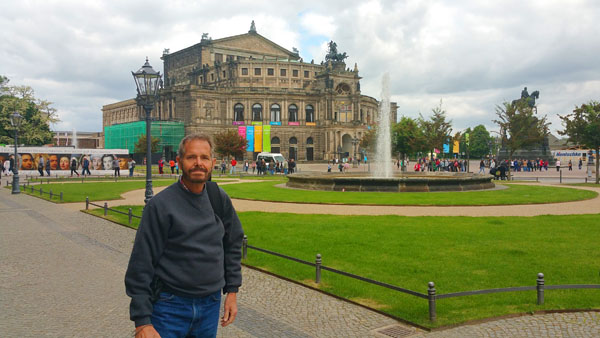
We walked through the large building on the east side of the Zwinger- the building that houses the art museum- using an archway that led into the central area of the palace. Just as we came through the archway, the entire four-sided palace and grounds opened up, and I could not resist immediately putting a panorama together.

The name Zwinger goes back to the common medieval German term for that part of a fortification between the outer and inner defensive walls, these walls dating from the 12th century and outer wall constructed beginning in 1427, during the Hussite Wars. The area got its name then, and it was used by the royal court at Dresden for garden purposes. Various maps show different shapes for the complex at its beginning and over the years. From these steps and from the balcony of the building where the WC was located, we took pictures of the four sides of the complex, and it is probably best to organize them that way.
South Side and Porcelain Museum
|
|
From a different spot a bit later, Fred used his zoom to get a good picture of the intricate sculpted decoration on the clock tower.
West Side: The Kronentor
|
The Kronentor gate originally made it possible to get access from outside the city through the fortress wall, but there was no stone bridge over the moat. Instead, a narrow wooden footbridge was used; it could have been dismantled quickly in case of an attack. Remains of this bridge were discovered during excavations for the expansion of the Zwingergraben in the 20th century.
This colonnade and gate were designed in Italian High Baroque early in the eighteenth century. The design of the building included a round arched passage in the pedestal floor as a gate tower. The passage is flanked by two pairs of columns, to which niches with sculptures were attached. Niche figures on the trench side are of Ceres and Bacchus. Different figures were used on the inside of the gate tower.
The ground floor features strongly entangled entablatures and other moderately "heavy" stonework. In contrast, the upper floor is a four-storey hall, which gives the building a graceful lightness. The attic is supported by crenellated entablature, squares, figurines, Saxon-Polish coat-of-arms, signature and crown, both on the courtyard side and on the trench side. On the Attica are twelve sculptures of various themed circles around Hercules, as well as the seasons. The Attic program with its Hercules figurine jewelry dates back to the time when the building was to be built as "The Hercules Gate". Other figures surround the onion-shaped dome on which four Polish eagles bear the Polish royal crown.
In the interior of the cupola, there was a spring-themed fresco (artist unknown), rich with images of flowers and other flora. Sadly, that fresco was destroyed in 1945.
This side of the palace appears in many of our pictures of the Zwinger complex; I liked its long, graceful lines, with the tower in the center and buildings that looked like anchors at either end;- a very "balanced" structure. Again, I've whittled down our pictures of the Kronentor to what I thought were the two best:
|
|
The Zwinger was constructed in stages from 1710 to 1728. Sculpture was provided by Balthasar Permoser. The Zwinger was formally inaugurated in 1719, on the occasion of the electoral prince Frederick August’s marriage to the daughter of the Habsburg emperor, the Archduchess Maria Josepha. At the time, the outer shells of the buildings had already been erected and, with their pavilions and arcaded galleries, formed a striking backdrop to the event. It was not until the completion of their interiors in 1728, however, that they could serve their intended functions as exhibition galleries and library halls.
North Side: Solarium and Garden House
|
That's also where Fred got a nice shot of the sculptural decorations over on the garden house adjacent, and that's where I took this picture of some of the sculpted figures on the facade of the solarium above me.
From this balcony Fred and I got a couple more pictures of the Zwinger that are certainly worth having a look at:
|
|
East Side: Old Masters Picture Gallery
|
As the fast-growing painting collection soon required more space for storage and presentation, it was moved from Dresden Castle to the adjacent Stallgebäude (the Electors’ Stables Building) in 1747. In the meantime the collection had achieved European fame. Paintings from all over Europe, especially from Italy, Paris, Amsterdam and Prague, were acquired and sent to Dresden. The purchasing activities of the Electors were crowned by the acquisition of Raphael’s Sistine Madonna in 1754.
In 1838, the architect Gottfried Semper was invited by a gallery commission working for King Frederick Augustus II, to design an appropriate architectural setting for the collection. The new gallery wing of the Zwinger was built from 1847 to 1854, and the New Royal Museum opened in the Semper Gallery where it is still located today.
In 1938, with World War II imminent, the museum was closed and the artworks safely stored away beneath the building. Thus, when the gallery building itself was severely damaged in the bombing of Dresden on 13 February 1945, the artworks were not. But at the end of the war in 1945, most of the paintings were confiscated by the Red Army and transported to Moscow and Kiev.
On their return to Dresden in 1955, part of the collection was displayed on the ground floor of the still partly destroyed Semper Gallery. The Old Masters Gallery re-opened in 1960 after the reconstruction of the gallery building was completed. While the most important paintings survived this period, the losses were significant. Records from 1963 state that 206 paintings had been destroyed and 507 were missing; only about 50 of those missing paintings have ever been located.
The Zwinger Palace: A Panoramic View
The view begins at the north side, looking towards the gardens, and pans eastward past the Old Masters Gallery, the clock tower and Porcelain Museum, the Kronentor, the Scientific Objects Museum and back to the gardens.
The Nymphenbad

The pool is surrounded by the French Pavilion (which up until now I'd referred to as a solarium, but this was the first time the guide mentioned the type of building), arched galleries, the fortress wall with water cascade and stairs, and a wing of the Old Masters Gallery; it forms an upwardly open, high-walled "room" with a square base. The Nymphenbad is not a bath in the real sense; it is more like a water theater. The design of the side walls with their exquisite decoration reminds one of an ancient nymphaeum. Today the Nymphenbad is a comparatively reserved version of the originally intended water features; the original plans for the Zwinger called for a large ring of fountains.
|
Halfway up the cascade there are blowing tritons on either side where the cascade transitions there from oblique to stepped. The are not the originals; those were damaged in World War II and are now in the Albertinum museum. On both sides, there are curved stairways that lead up to the rampart; these are decorated with sculpted dolphins and other figures.
The operation of the Nymphenbad required a considerable amount of technical effort, since at that time there were no electric pumps. The main problem was to raise sufficient amounts of water to the level of the upper wall area so that it could flow down the cascade. In order to accomplish this, a complex installation of classical water transport was necessary. A copper water container was built in the nearby tower of the Wilsdruffer Gate, which was filled with water from the Gorbitzer Fountain by a ladle (an incredibly labor-intensive operation). A complex system of pipes brought water from this container to the Zwinger Nymphenbad.
This system also fed smaller cascades on both sides of the Kronentor as well as other small fountains in the Zwinger. As a side note, and in a foretelling of today's amusement park flume rides, users of the stairs on either side of the cascade got sprayed with water when the cascade was operating.
|
 |
Six of the nymph figures and the water-spitting dolphins date back to Balthasar Permoser (1651–1732), who was among the leading sculptors of his generation and whose evolving working styles spanned the late Baroque and early Rococo, and his students. Permoser did most of the sculpture for the Zwinger, but some of the nymphs for the niches were created by his students, and on one of them one artist, Kirchner, added a bouquet of flowers. Either our guide neglected to tell us, or I didn't hear, but the sculptures we saw today (ostensibly Baroque) are actually copies of the originals. The originals that were not damaged in the war are now in the Royal Museum here in Dresden.
Here is a nice picture that Prudence took of Karl, Fred and me beside the pool, and below are the movie I made here in the Nymphenbad as well as a picture Fred took of some of our tour group just outside the French Pavilion (notice the building decoration here) looking at the Nymphenbaden:
|
|
Our tour guide then took us up one of the stairways by the cascade; it was not running at the moment, so no danger of getting wet. At the top of the cascade we were on a kind of large balcony where we could look down into the Nymphenbad, but it was blocked off so you couldn't get right to the edge to look down.
|
I had a very good view of the Garden House or at least the amazingly decorated top part of it; you can see that decoration in my picture at left. As for the sculpted figures, have a look at some of the pictures I took of them:
 (Click on Thumbnails to View) |
With all my picture-taking, I'd gotten a little bit behind the tour group, so I hastened to follow them down the path that led from the top of the Nymphenbad down to the Theatreplatz.
|
Carl Maria Friedrich Ernst von Weber (1786-1826) was a German composer, conductor, pianist, guitarist and critic, and was one of the first significant composers of the Romantic school. Weber was born near Lübeck, the eldest of the three children of a German music director and a Viennese singer. (Wolfgang Amadeus Mozart married one of Weber's nieces.) By the age of 4, Carl was already a capable singer and pianist.
Weber's father gave him a comprehensive education, and in 1798 he went to Salzburg to study with Michael Haydn, the younger brother of Joseph Haydn; he also studied with the singer Johann Evangelist Wallishauser and organist Johann Nepomuk Kalcher. That same year his first work was published- six fughettas for piano. In 1803, Weber's opera, Peter Schmoll und seine Nachbarn (Peter Schmoll and his Neighbors) was produced in Augsburg, and gave Weber his first success as a popular composer. After an unsuccessful stint as Director of the Breslau Opera, he became private secretary to Duke Ludwig, brother of King Frederick I of Württemberg. He was a prolific composer during this period, writing a quantity of religious music, mainly for the Catholic mass.
He achieved success with the Concertino in E-Flat Major and the two concerti J. 114 and J. 118; he went on tour with Baermann playing the clarinet parts, and it was this tour that changed public, critical and royal opinions of Weber's work. From 1817 onwards he was director of prestigious Opera in Dresden, and in 1819 wrote his most famous piano piece,Invitation to the Dance. He continued to compose, writing a number of notable pieces, and in 1824 received an invitation from The Royal Opera, London, to compose and produce Oberon, based on Christoph Martin Wieland's poem of the same name. Weber accepted the invitation, and in 1826 he travelled to England, to finish the work and conduct the premiere on 12 April. Although suffering from TB, he conducted the premiere and twelve sold-out performances during April and in May. He died on 5 June at age 39. He was initially buried in London, but 18 years later his remains were transferred to the family burial plot in the Old Catholic Cemetery in Dresden. The simple gravestone was designed by Gottfried Semper (the Zwinger architect) and his reburial eulogy was performed by Richard Wagner.
Just before rejoining the tour group, I took two other pictures worth including here.
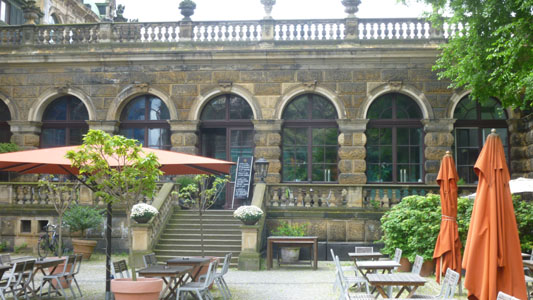 The Zwinger Cafe |
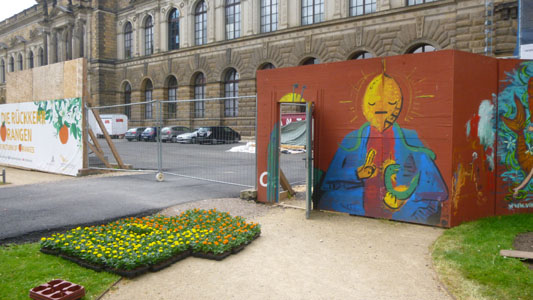 Springtime Comes to Dresden |
Semperoper Dresden (Dresden Opera House)
|
The Theaterplatz is not actually located within the historical center of the city but on the edge of it to the west, so one does not see a concentration of building around it. North of the square, a group of buildings called the Italian Village separates the square from the Elbe. Those are relatively young buildings.
South of the square, of course, is the façade of the Sempergalerie of the Zwinger (Neo-Renaissance in appearance). Also adjacent to the square off its southeast corner is the former Old Town Main Station; the building now houses both the Dresden Tourist Office as well as the box office for the Semperoper.
Dominating the Theatreplatz is the statue of the Saxon King Johann; the statue was created in 1889 by Johannes Schilling. King Johann of Saxony (1801-1873) ruled from 1854 to 1873; he was a scholar on the throne of Saxonia. Much information about him was written on the socle of the monument; it was there that we learned that Johann was a linguist and a jurist by training.
|
While we are here, looking at this image of the opera house, I'd like to let you look at some of its elements up close. There are four of these. If you click on the quadriga (chariot and four horses) on top of the building, you can see Fred's closeup. The ceiling of the half dome above the entrance was intricate and colorful; click on it and you can see Fred's closeup view. Finally, you can just see two niches with statues, one at each end of the facade at the first floor level; click on each of them to see the closeup picture that we took of it.
We learned a lot about the building from our tour guide.
The first opera house at the location of today's Semperoper was built by the architect Gottfried Semper. It opened in 1841 with an opera by Carl Maria von Weber. The building style itself is debated among many, as it had features that appear in three styles: early Renaissance and Baroque, with Corinthian style pillars typical of Greek classical revival. Perhaps the most suitable label for this style would be eclecticism, where influences from many styles are used, a practice most common during that period. Nevertheless, the opera building, Semper's first, was regarded as one of the most beautiful European opera houses.
|
The building is considered to be a prime example of "Dresden Baroque" architecture. On top of the portal there is a Panther quadriga with a statue of Dionysos. The interior was created by architects of the time, such as Johannes Schilling. Monuments on the portal depict artists, such as Johann Wolfgang von Goethe, Friedrich Schiller, William Shakespeare, Sophocles, Molière and Euripides. In the pre-war years, the Semperoper premiered many of the works of Richard Strauss.
In 1945, during the last months of World War II, the building was largely destroyed again, this time by the bombing of Dresden and subsequent firestorm, leaving only the exterior shell standing. Exactly 40 years later, on 13 February 1985, the opera's reconstruction was completed. It was rebuilt to be almost identical to its appearance before the war, but with the benefit of new stage machinery and an accompanying modern rear service building . The Semperoper reopened with the opera that was performed just before the building's destruction in 1945, Carl Maria von Weber's "Der Freischütz". When the Elbe flooded in 2002, the building suffered heavy water damage. With substantial help from around the world, it reopened in December of that year.
Our tour was about to leave the Theaterplatz, and we followed, but not before taking a few final pictures, including one of the new, but antique-looking antique-looking lampposts in front of the Semperoper. Here are two final pictures taken from the Theaterplatz:
|
|
The Schlossplatz
|
Other notable sites in and around the square are the Catholic Cathedral, the statue to Friedrich Augustus, the city courthouse and the Augustus Bridge over the Elbe.
Actually, all of the buildings around the square were either destroyed in the war or so heavily damaged that they had to be completely rebuilt. The city of Dresden and the government of Germany did a wonderful job after the war in rebuilding the area. This effort really moved into high gear at the time of German reunification, and so in recent years the buildings surrounding the square have largely been restored so that the area again has a historic character.
As we came around the west side of the cathedral, vistas of the Elbe opened up, and I stopped to take a panorama of the area. The image below shows the west side of the cathedral, Theaterplatz, the Italian Village (mentioned earlier), the Elbe, and the Augustus Bridge:

A bronze statue of Albert of Saxony by sculptor Max Baumbach was placed in the square in 1906, but it was destroyed in the war. A sculpture of Frederick Augustus I by Ernst Rietschel in seated position now stands on the site of the old Albert statue. This monument had been located at the Dresden Zwinger since 1843, but was moved here in 2008.
|
Designed by architect Gaetano Chiaveri from 1738 to 1751, the church was commissioned by Augustus III, Elector of Saxony and King of Poland. The general population was Protestant, but the ruling class was Catholic; Augustus built the cathedral for his own use and for the use of other high-ranking officials, connecting it to his home (Dresden Castle) with an ornate high level walkway. Numerous members of the ruling family are buried in the church's crypt.
The church was badly damaged in February 1945 during the bombing of Dresden in the Second World War. It was initially restored during the mid-1980s by the East German government. It was further restored following reunification, including the rebuilding of the bridge to the castle. The cathedral features a carefully restored organ, the last work of the renowned organ builder Gottfried Silbermann. It also contains a Rococo pulpit by Balthasar Permoser. I wanted to go into the church, but the tour was moving on and I didn't want to lose them.
Outside the main entrance of the Katholische Hofkirche is a paving stone marked with an N, called the Napoleon Stone; it indicates the spot where Napoleon Bonaparte paraded his troops and set off for the Battle of Dresden on August 26, 1813, in which he was victorious.
The Dresden Frauenkirche (Protestant Church)
|
 |
Alongside the courthouse, there was a broad staircase that led up to a restaurant and patio on top of the buildings along the Elbe. I jogged up there to see what I could see, and it turned out that there were pretty nice views of the buildings on the other side of the Elbe. I have since discovered that this area is called Carolaplatz, and that the red brick buildings are state government offices. You can also see a kind of amphitheatre right along the river; I asked the guide about it and it turns out that they show movies there on pleasant evenings.
I came back down to rejoin Fred, where I got a nice picture of him with the Elbe River in the background; you can see that picture here. I also tried my hand at putting together another panoramic view of the river, and it turned out pretty good, aside from an abrupt lighting change between two of the pictures:

We followed our tour guide as he led us down some stairs and then along the Elbe, turning back into the city and going through an arched tunnel underneath a promenade. We stopped inside the tunnel and the guide pointed to a mark high up on the inside wall. He told us that this marked the level the waters of the Elbe reached during the major flooding in 2002; this mark was actually above our heads. While he was talking I took a picture of the neat view of the Elbe through the tunnel.
|
|
After taking a picture of Prudence and Nancy at the entrance to a restaurant (the first picture in the slideshow at left) I myself went kind of slowly taking pictures, and the tour group got ahead of me. I watched where they went, though, so I wouldn't lose them. I took a little side trip to take a couple of pictures, and I took more as I followed the tour route and eventually caught up with the group at the Protestant Church we were to see.
These pictures form a sequence, so I have put them in a slideshow at left, in the order in which I took them. Each has a bit of explanation along with it. As usual with these slideshows, move from one picture to the next with the little arrows in the lower corners of each slide, and track your progress with the index numbers in the upper right.
As I said, I caught up with the tour group outside the Frauenkirche Dresden, a church that was reconstructed, like a jigsaw puzzle with missing pieces, after its destruction in the bombings of World War II.
|
A Catholic church dedicated to "Our Lady" was first built near this site in the 11th century; during the Reformation it was converted to a Protestant church. This first Frauenkirche was torn down in 1727 and replaced by a new, larger Lutheran church with a greater capacity; even though Saxony's Prince-elector, Frederick August I, had converted to Roman Catholicism to become King of Poland, he supported the construction which gave an impressive cupola to the Dresden townscape. The architect's distinctive design for the church captured the new spirit of the Protestant liturgy by placing the altar, pulpit, and baptismal font directly in the center in view of the entire congregation. In 1736, famed organ maker Gottfried Silbermann built a three-manual, 43-stop instrument for the church. The organ was dedicated on 25 November and Johann Sebastian Bach gave a recital on the instrument six days later.
The church's most distinctive feature was its 300-foot-high dome- an engineering feat comparable to Michelangelo's dome for St. Peter's Basilica in Rome. The 12,000-ton sandstone dome rested on eight slender supports, but proved very reliable- surviving even a hundred cannonball hits during the Seven Years' War. The completed church gave the city of Dresden a distinctive silhouette, and for more than 200 years stood over the skyline of old Dresden, dominating the city.
But sadly the building proved no match for advancements in destructive armaments. On 13 February 1945, Anglo-American allied forces began the bombing of Dresden; the church withstood two days and nights of the attacks and the eight interior sandstone pillars supporting the large dome held up long enough for the evacuation of 300 people who had sought shelter in the church crypt. The sheer violence of the bombing, and most particularly the 650,000 incendiary bombs that were dropped on the city, caused the temperature surrounding and inside the church to reach 1,830°F and the dome finally collapsed at 10 a.m. on 15 February. The stone pillars glowed bright red and exploded; the outer walls shattered and nearly 6,000 tons of stone plunged to earth, penetrating the massive floor as it fell.
|
The beautiful building vanished from Dresden's skyline, and the blackened stones lay where they fell for the next 45 years as Communist rule enveloped the new East Germany. During the early years, Dresden residents salvaged unique stone fragments, numbered them, and set them aside against the day when the church might be rebuilt. The authorities wanted to clear the ruins away to create (as Joni Mitchell would sing in "Big Yellow Taxi") a parking lot, but popular sentiment against the move was intense and instead, in 1966, the ruins were officially declared a "memorial against war".
But the ruins still had another role to play. In the early 1980s, peace demonstrations began to be held there, and these demonstrations evolved into peaceful protests against the East German regime. On many occasions, hundreds of the citizens of Dresden came to the ruins with flowers and candles, part of a growing East German civil rights movement. By 1989, the number of protesters in Dresden, Leipzig and other parts of East Germany had increased to tens of thousands, and the wall dividing East and West Germany toppled. This opened the way to the reunification of Germany- and the beginning of the fulfillment of the dream long-held by Dresden residents. The Frauenkirche must be rebuilt.
The desire to rebuild the church actually surfaced during the last months of World War II, but due to political circumstances in East Germany, the reconstruction came to a halt. The heap of ruins continued to serve as a war memorial- similar to Coventry Cathedral in England. Because of the continuing decay of the ruins, Dresden leaders decided in 1985 (after the Semperoper was finally finished) to rebuild the Church of Our Lady after the completion of the reconstruction of the Dresden castle.
|
The project gathered momentum as hundreds of architects, art historians and engineers sorted the thousands of stones, identifying and labeling each for reuse in the new structure while others worked to raise money. One German-born American founded a US organization dedicated to supporting the reconstruction, and in 1999, the winner of the Nobel Prize for medicine and donated his $1 million award to the organization. Even in Britain, the Dresden Trust had the Duke of Kent as its royal patron.
Rebuilding the church cost $200 million. Dresdner Bank financed more than half of the reconstruction costs via a "donor certificates campaign", and the bank and its employees contributed some $10 million. Funds raised were turned over to the "Frauenkirche Foundation Dresden", with the reconstruction backed by the State of Saxony, the City of Dresden and the Evangelical Lutheran Church of Saxony. The new golden tower cross was funded officially by "the British people and the House of Windsor". It was made by a British blacksmith whose father was one of the bomber pilots who were responsible for the destruction of the church.
Near the site of the rebuilt church stands a section of the original wall of the church; for engineering reasons, the rebuilt church does not occupy the exact footprint of the original, and this section of church wall commemorates the original location. This wall section was constructed from stones that were, for engineering or other reasons, not used in the reconstruction of the church. It is now standing in for the ruins of the church as a monument to the destruction of the city during the war.
Using original plans from builder Georg Bähr from the 1720s, the Dresden City Council decided to proceed with reconstruction in February 1992. A rubble-sorting ceremony started the event in January 1993 under the direction of the church architect and engineer. The foundation stone was laid in 1994, and stabilized in 1995. The crypt was completed in 1996 and the inner cupola in 2000. Seven new bells were cast for the church and rang for the first time for the Pentecost celebration in 2003. The exterior was completed ahead of schedule in 2004 and the painted interior in 2005. The intensive efforts to rebuild this world-famous landmark were completed one year earlier than originally planned, and in time for the 800-year anniversary of the city of Dresden in 2006.
|
Of the millions of stones used in the rebuilding, more than 8,500 original stones were salvaged from the original church and approximately 3,800 reused in the reconstruction. As the older stones are covered with a darker patina, due to fire damage and weathering, and you can see this difference in most of our pictures of the reconstructed church. In addition, two thousand pieces of the original altar were cleaned and incorporated into the new structure.
The builders relied on thousands of old photographs, memories of worshippers and church officials and crumbling old purchase orders detailing the quality of the mortar or pigments of the paint. The oak doors were relatively easy to duplicate; citizens submitted hundreds of wedding albums containing pictures of wedding couples standing in front of them. As I mentioned above, the new gilded orb and cross on top of the dome was forged by London silversmiths using the original 18th-century techniques as much as possible. The son of an aircrew member who took part in the bombing led this effort. In February 2000, the cross was ceremonially handed over by The Duke of Kent.
Thus the external structure of the Frauenkirche was completed, and for the first time since the last war, the completed dome and its gilded cross graced Dresden's skyline. The cross that once topped the dome, now twisted and charred, stands to the right of the new altar.
A bronze statue of Martin Luther, reformer and theologian, which survived the bombings, has been restored and again stands in front of the church. It is the work of sculptor Adolf von Donndorf from 1885. Of course, this is an active church, with devotional services daily and two liturgies every Sunday. Our tour group had to wait a few minutes until one of those devotional services ended before we entered the church. Just as I went through the entrance, I took a picture looking up the side of the building.
|
Unlike most other churches that we have been in, here in the Church of Our Lady, the organ was actually located in the front of the church, above the altar- not in the back of the church as seems to be the more normal situation. In the picture of the chapel at left, you can see the pipes of the organ above the altar, and you can see them even more clearly here.
I want to include one more picture of the intricate and beautiful altar area; this one was taken by Prudence and was the best of our photos to show the detail of the decoration at the front of the church. So have a look at her closeup of the ornate altar.
Our tour group entered the church and we all had a few minutes to explore the interior. The interior design was certainly beautiful.
|
|
One of the hardest things that the reconstruction team had to do was match the type of paint that had been used in the destroyed building; paint made with egg as one of the ingredients is almost a lost art, and even though the rebuilders had extensive notes and plans to work from, getting the same luminous quality from today's modern paint took some doing.
The interior of the nave was a good deal different than the other churches we've visited; for one thing, there were congregant balconies all around the interior- something like a symphony hall. Usually, in the churches we've visited, if there are any balconies at all they are to be found at the back of the church (where the organ is also usually located). In the Church of Our Lady, the back of the church has three levels of balconies- certainly not something we've yet seen. Here are two panoramic views of the inside of the Church of Our Lady- the second one focusing on the dome above our heads:

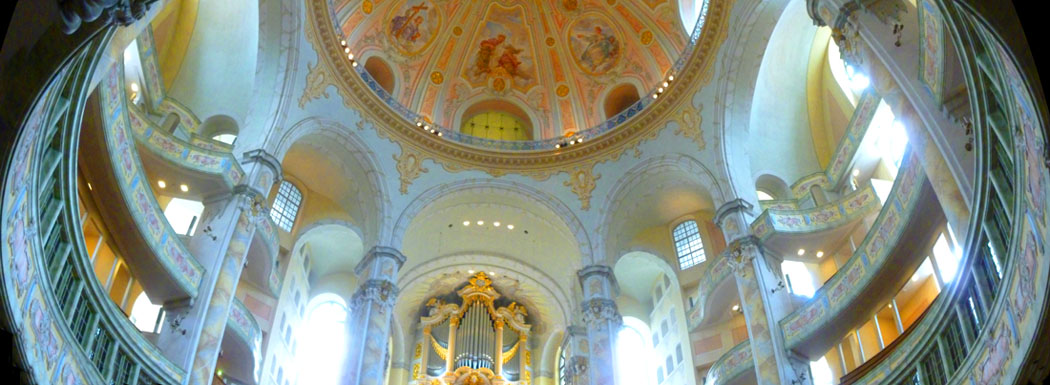
Our visit to the Church of Our Lady was really interesting. Although the church was not as ornate inside as many we have seen, in light of its history- having been totally destroyed and then rebuilt as close as possible to the original plans and specifications- it was more significant than most.
The Fürstenzug
|
The Fürstenzug (English: Procession of Princes) is a large mural of a mounted procession of the rulers of Saxony. It was originally painted between 1871 and 1876 to celebrate the 800th anniversary of the Wettin Dynasty, Saxony's ruling family. In order to make the work weatherproof, it was replaced with approximately 23,000 Meissen porcelain tiles between 1904 and 1907. With a length of 335 feet, it is the largest porcelain artwork in the world. The mural displays the ancestral portraits of the 35 margraves, electors, dukes and kings of the House of Wettin between 1127 and 1904.
The Fürstenzug is located on the outer wall of the Stallhof (Stables Courtyard) of Dresden Castle; this long arcade building has a blank wall as it faces Auguststrasse, and that's where the mural was installed. By 1589, this outer wall was already decorated with a fresco.
|
For the upcoming 800th anniversary of the House of Wettin in 1889, another stucco version of a large-scale mural was commissioned. It was painted by the artist Wilhelm Walther between 1871 and 1876. Since the picture rapidly deteriorated, it was replaced with about 23,000 Meissen porcelain tiles between 1904 and 1907.
The mural depicts the 35 Saxon margraves, electors, dukes and kings from Conrad, Margrave of Meissen, who ruled in the 12th century, to George of Saxony who was king for only two years in the 20th century. The only ones missing are Heinrich I von Eilenburg (c. 1089) and the last king of Saxony, Frederick Augustus III, who ruled from 1904 to 1918. Also shown are 59 scientists, artisans, craftsmen, children and farmers.
You might wonder why the mural seems to be in such good shape, considering that the city of Dresden was literally flattened towards the end of World War II. As a matter of fact, the mural partially collapsed when the building it is affixed to was severely damaged. So what saved it?
|
But still, how did the tiles survive the incredible heat of the incendiary bombs that raised the temperature of solid stone to over 1500° for a time? The answer, of course, is that the tiles were already kiln-fired porcelain, and the temperature at which that firing occurred was even greater than 1500°. We were given to understand that only a few of the tiles were actually broken in the partial collapse of the wall; those were repainted and refired when the mural was repaired.
We walked along the mural, listening to our guide describe it, and taking photographs as we went. We took a lot of them, but here are a couple that are representative:
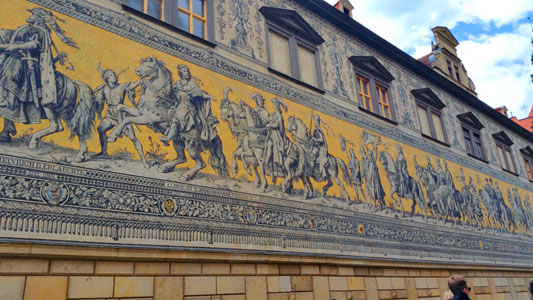 |
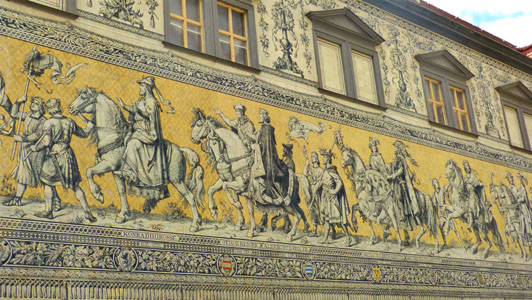 |
Our guide didn't detail the identities of all the figures in the mural (although that information is available online these days). He did draw our attention to the legend below the figures in the mural (actually part of the mural itself) that name the major figures. Here are two more good pictures we took of the mural:
|
|
As we walked along the mural, I got my usual idea of trying to "document" it by taking a series of pictures that I could interlock into a huge panorama. So I returned to the start of the mural, positioned myself on the curb at the other side of the street, and took a picture of the first section.
|
There have been other cases where I've messed up a shot of something that I wanted to put on an album page, and have been tempted to go to the Internet to find the shot I wanted, but I've always thought this to be cheating in a way; what's the point of a personal photo album if it's filled with other people's pictures? But here is one case where I thought I came close enough to achieving my purpose that I feel OK about grabbing a professionally-done panorama of the mural and putting it here for you to look at, and so that's what I've done, using an image from Wikimedia Commons- uploaded by a contributor named Kolossos. That image is in the scrollable window below:
When we got to the end of the mural, we turned to our left and headed through the Georgentor Gate (which we'd seen earlier). On either side of the archway there were interesting sculptures. As we went through the gate, we found that just on the other side there was an archway where we could look into Dresden Castle and see the former stable area on the other side of the long arcade building to which the Furstenzug was affixed. If you will look at the arched arcade on the left, you will see some iron figures affixed to each column; Fred thought they were interesting and so he took a closeup view of them. At the gate and along Schlossstrasse a number of interesting architectural details caught Fred's eye; here are a few of them:
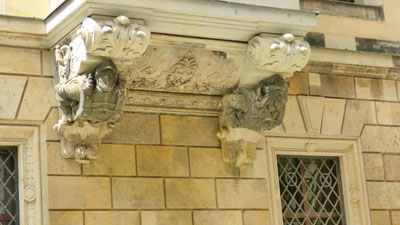 |
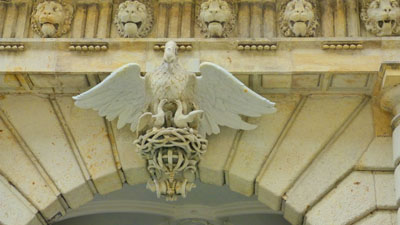 |
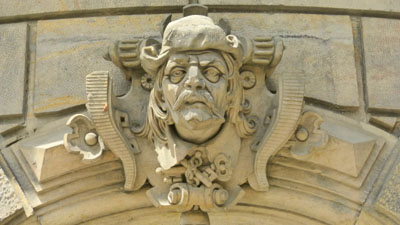 |
At the end of the block I turned to look back at the Georgentor Gate- this time from the city side. At the intersection with the next street, our tour guide ended the guided part of our walk around Dresden, pointing out where the bus would be waiting, the direction back to Neumarkt and some restaurants we might patronize for lunch, and the location of the Royal Art Museum that Prudence and Nancy wanted to visit. He cautioned us to be back at the bus promptly at 5PM for the ride back to Berlin and then sent us off on our own.
Lunch and Neumarkt Square
|
So while the group headed back towards the square, I turned the opposite way and went back over to Theatreplatz where the tourist office was located just at the corner of the Semper Gallery (part of the Zwinger). I got a couple of maps (and also took off my t-shirt as the day was warming up) and then took a shortcut back to the restaurant, once again going around through Schlossplatz and retracing the route the tour had taken earlier. I took three more pictures in the plaza- of the Catholic Cathedral, next to it the Georgentor- the old city gate- and finally, on the east side of the plaza, the courthouse, with the sculpture of Frederick Augustus in front. Then I scooted along the way the tour group had gone, coming up on the Edelweiss Restaurant from the north. There, I found everyone else was just sitting down and getting ready to order. As usual, Fred and I settled on something to share, as did Prudence and her sister.
The Neumarkt is a central and culturally significant section of the Dresden inner city. The historic area was almost completely wiped out during the Allied bomb attack during the Second World War. After the war Dresden fell under Soviet occupation and later the communist German Democratic Republic who rebuilt the Neumarkt area in socialist realist style and partially with historic buildings. However huge areas and parcels of the place remained in ruins. After the fall of Communism and German reunification the decision was made to restore the Neumarkt to its pre-war look.
|
|
During the bomb attack on Dresden in February 1945, the area around the Neumarkt was almost entirely destroyed in the resulting firestorm. The main structure of the Frauenkirche survived the initial bombing and firestorm, before collapsing a few days later. During the 1950s and 1960s under rule of the German Democratic Republic, the Neumarkt and Altmarkt formed a mostly vacant area through the middle of the old city, save for the ruins of the Frauenkirche standing as a memorial to the horrors of war. The two squares were separated by the widened Wilsdruffer Strasse, then from 1969 by the Palace of Culture, and then later by new apartment blocks.
The completion of the reconstructed Dresden Frauenkirche in 2005 marked the first step in rebuilding the Neumarkt. Organisations such as the Gesellschaft Historischer Neumarkt Dresden actively encourage an historically-faithful reconstruction of the structures around the Neumarkt, giving an outward appearance as close as possible to that from before 1945. The areas around the square have been divided into 8 "Quarters", with each being rebuilt as a separate project, the majority of buildings to be rebuilt either to the original structure or at least with a facade similar to the original.
|
Here are more of the pictures we took around the Neumarkt during and just after lunch:
 (Click on Thumbnails to View) |
Shortly after we ordered lunch, Nancy said she wanted to go across the square to a jewelry store that the group had passed on their way to the Edelweiss. Nancy is "into" rings and things, and wanted to see if she could find something as a Dresden souvenir. I volunteered to go with her, and we headed around the square to the shop she'd seen. I waited with her while one of the store personnel showed her various things. I didn't actually think she would buy something, but she did- a very nice and quite expensive diamond ring. Most people collect souvenir spoons or other such things from their travels, but Nancy collects jewelry. Here she is, completing her purchase. We got back to the Edelweiss just as the food was being delivered and had a pleasant lunch. Afterwards, Ron wanted to hang out and have a cigar, while Prudence, Nancy and Karl wanted to visit the Royal Art Museum in the Castle. Fred and I wanted to walk around, so we all split up, to meet again around 5PM at the bus.
Fred and I Walk Around Dresden
|
We began by going north from the Edelweiss Restaurant down the street to the Elbe, where we went through one of the arched tunnels to the riverside. There, we found a stairway up to the promenade that runs along the river from the Schlossplatz to the gardens east of the Academy of Fine Arts; it is known as Brühl's Terrace. We were going to walk along that promenade to the east to visit some gardens marked on our tourist map.
Brühl's Terrace Along the Elbe
|
|
Just before we reached the buildings of the Academy of Fine Arts, I paused and asked Fred to stand still while I took a series of pictures to create an almost 360° panorama. That image is in the scrollable window below:
Then, continuing our walk down Brühl's Terrace, we came to the Academy of Fine Arts and the beautiful old building that fronts on the Elbe River. The complex is actually quite large and possesses one of the most iconic spires that form the Dresden skyline. The Dresden Academy of Fine Arts is a vocational university of visual arts. The present institution is the product of a post-World-War-II merger between the famous Dresden Art Academy, founded in 1764, the workplace and training ground of a number of influential European artists, and another well-established local art school, Hochschule für Werkkunst Dresden.
|
On the side of the building facing the Elbe, the names of Pheidias, Iktinos, Praxiteles, Polykleitos, Lysippos, Erwin von Steinbach, Leonardo da Vinci, Michelangelo, Raphael and Dürer are inscribed (while on the other side the motto "For the Honor and Adornment of the Fatherland" is inscribed.
Atop the building at either end are golden figures that give the entire building the appearance of magnificence.
The Academy is one of the two leading instutitions in Germany for artists-in-training. It offers not only classes in various visual arts, but also exhibition space for those artists. Its reputation as a selective institution has meant that artists who attend will have high visibility for their works.
|
|
Apparently, Dresdenites eat more lemons than they do oranges, because the nickname of this dome is "the Lemon Squeezer".
Atop the dome is a golden sculpture of Pheme, a figure in Greek mythology. Pheme (or Fama as she was known by the Romans) was the personification of fame and renown, her favor being notability, her wrath being scandalous rumors. She was a daughter either of Gaia or of Elpis (Hope), was described as "she who initiates and furthers communication", and had an altar at Athens.
A tremendous gossip, Pheme was said to have pried into the affairs of mortals and gods, then repeated what she learned, starting off at first with just a dull whisper, but repeating it louder each time, until everyone knew. In art, she is usually depicted with wings and a trumpet- as she is here in Dresden. There were some differences in her appearance and actions in the Roman mythological universe. In that mythology, Fama ("rumor") was described by the poet Virgil in the Aeneid as having multiple tongues, eyes, ears and feathers. Virgil wrote that she "had her feet on the ground, and her head in the clouds, making the small seem great and the great seem greater."
|
I thought the building was quite beautiful in its simplicity, but Fred noticed immediately the decoration above the main entrance facing the river. His zoom photo of it turned out well, and you can have a look if you will just click on the triangular area above the columns in the center of the building.
As we were walking along, the day was getting nicer and nicer, and the views up and down the river were a lot better than they'd been earlier in the day- as the view above across the river attests.
|
At right is a small panorama that I made of the riverfront from here in front of the Academy, and I also took one picture looking upriver.
The Brühlscher Garten
|
So you may wonder who this von Brühl character was. As it turns out, he was a Saxon statesman (1700-1763) who gained importance as a Elector-Saxon and Royal-Polish Prime Minister (1746-1751). It was good time to be an Elector; he and his contemporaries led an extravagant lifestyle- so extravagant that their excesses were one of the reasons for the economic decline of the Electorate of Saxony.
Today only the Brühlscher Garten is preserved. Some of the sculptures of the Palais Brühl have been transferred to its successor building, the House of Estates near the Albertinium, but still present in the garden are two sphinxes and a pretty waterfall and fountain. Both Fred and I made movies at the fountain; Fred's movie suffers a bit from losing focus when he zooms, and mine suffered from wind noise from the stiff breeze along the terrace. The narration for my movie doesn't add much, so I've removed the sound:
|
|
Today, Brühlscher Garten (Brühl's garden) refers to the east side of Brühl's terrace. The garden was designed as a French garden, and it originally consisted of the Belvedere and the western part of the Brühl Palace. In 1814 the garden was made accessible to the public.
|
 (Click on Thumbnails to View) |
The New Synagogue
|
|
While the old city is being rebuilt with buildings whose exteriors, at least, are precise replicas of the baroque royal city that long made Dresden famous, the synagogue is not a replica of the historic Semper Synagogue. It is a modernist statement that contrasts with its neighbors.
Inside, the sanctuary building is a cube (all service functions are located in the companion building set at the other end of a stone plaza.) Within this cube is set a square worship space, curtained off on all four sides by an enormous draping of curtains made of chain-mesh in a golden metal, evoking an echo of the scale of the Temple at Jerusalem.
The German-British Rose Garden
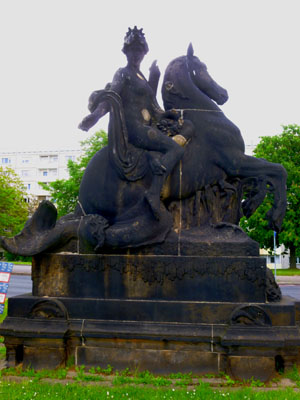 |
A plaque describing the different rose varieties also says: “This Rose Garden is dedicated to the many Dresdeners of all faiths as well as to the refugees who died in the Firestorm of the 13th and 14th February 1945. The Rose Garden serves as a symbol for reconciliation between the United Kingdom and Germany and expresses our hope for a peaceful co-existence of all peoples.”
|
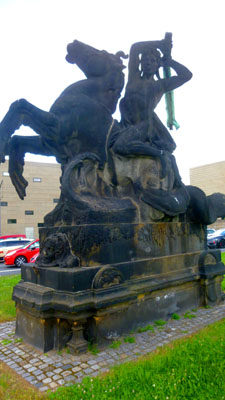 |
The Dresden Trust was founded in 1993 with the aim to support the reconstruction of Dresden’s Frauenkirche with donations from British people. The most important contribution, however, were the Orb and Cross made for the Frauenkirche after the original plans by Alan Smith, a London goldsmith, whose father was one of the bomber pilots involved in the attack on Dresden. As part of its reconciliatory work with Germany, the Dresden Trust also supports student and other exchange projects.
Dresden Police Station
The Ampelmännchen (German: literally little traffic light men) is the symbol shown on pedestrian signals in the former East Germany when pedestrians are to cross. The Ampelmännchen is a beloved symbol in Eastern Germany, "enjoying the privileged status of being one of the few features of communist East Germany to have survived the end of the Iron Curtain with his popularity unscathed." After the fall of the Berlin Wall, the Ampelmännchen acquired cult status and became a popular souvenir item.
|
Peglau's secretary Anneliese Wegner drew the actual Ampelmännchen figures per his suggestions; fingers were proposed, then dropped. The result was a "perky", "cheerful" man with a "petit bourgeois" hat (inspired by a summer photo of Erich Honecker in a straw hat). Prototypes were constructed and officially introduced in 1961 in East Berlin, and were immediately successful. Decades later, Der Spiegel, described the Ampelmännchen as uniting "beauty with efficiency, charm with utility, [and] sociability with fulfilment of duties".
|
Following the German unification in 1990, the East German Ampelmännchen became endangered; the first solidarity campaigns for the Ampelmännchen took place in Berlin in early 1995. One designer incorporated Ampelmännchen into lamps, and these became very popular. Designer Karl Peglau explained the public reaction in 1997:
"It is presumably their special, almost indescribable aura of human snugness and warmth, when humans are comfortably touched by this traffic symbol figure and find a piece of honest historical identification, giving the Ampelmännchen the right to represent a positive aspect of a failed social order."
The Ampelmännchen became a virtual mascot for the East German nostalgia movement, and they were eventually returned to pedestrian crossings, including all western districts of Berlin in 2005. Other German cities, such as Dresden, adopted them as well. So former East Germans, who have long felt the underdog in cultural and political struggles, can point to at least one "victory" post-unification.
With that little digression, we crossed the street, passed by the side of the Albertinium and headed towards the building that houses the Dresden main police station.
|
In 1945, the Soviet Military Administration in Germany approved the arming of the community-level police forces; the forces which had been established in the regions of Germany the Soviet Union had occupied following World War II. In 1946 the name Volkspolizei began to be used and by August the organisation was placed under the control of the German Administration of the Interior. The first Volkspolizisten were mostly former Wehrmacht officers who had become communists, as well as former German members of the International Brigades in the Spanish Civil War. The "Volkspolizei" were organized in the same style as the Soviet military.
In the spring of 1949, the SVAG ordered that the Volkspolizei be purged of all "undesirable officers". This label included anybody who had served in the Wehrmacht and anybody with connections in the West. People not deemed sufficiently committed to the communist cause were also dismissed. With these purges, the SVAG created a force that was steadfastly loyal in its politics. To further instill the correct politics into Volkspolizei officers, the Main Administration of Training was established in 1949. By 1950, East Germany, though officially still without an army, was able to muster a well organised and well-armed security force, and with the establishment of the Volkspolizei came the foundations of the future National People's Army.
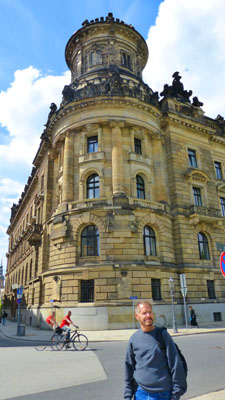 |
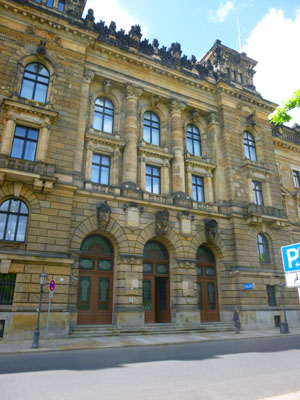 |
In preparation for German reunification in East Germany, five federal states were founded. Every state created its own police forces. Every former Volkspolizei officer could apply for a job with the new police if he had not worked as an agent for the Stasi. Just before and after the reunification every Volkspolizei officer had to undergo a new training based on West German law. Even in the 21st century, there is much social stigma connected with being a former "VoPo", and the blame of having been on the "wrong side" during the Cold War is often leveled against many ex-Volkspolizei officers to this day.
Today, this building still serves as Dresden's main police station, but it the type of place you and I are familiar with- not a place necessarily to be feared but rather one to which a citizen might go for help and for enforcement of law. After 30 years, the building's reputation is well on its way to rehabilitation.
Just as we were leaving to head back to the Neumarkt, I happened to notice an antique car came by, driven by a tour guide and with tourists in the back. Dresden has many of these old vehicles that are used for tours, and there are also horse-drawn carriages and wagons that are used for the same purpose. We headed up a side street towards the Neumarkt, and we could see (and actually we were rarely out of sight of) the dome of the Frauenkirche.
Archaeological Work Underway on the Neumarkt
|
| "From September 2016 until the summer of 2017 the Archaeological Heritage Office in Saxony is conducting excavations in the quarter west of the Frauenkirche between Sporergasse and the Kulturpalast in an area covering some 20,000 square feet. This will be the last of the extensive excavations in this area which have been going on for almost 20 years. This site is of high archaeological importance. According to Saxony's Heritage Law, archaeological sites must be excavated prior to imminent destruction by development projects. Excavations have substantial support from the company that will build an apartment and office building here. Our excavation site formed part of the medieval town of Dresden and was a densely built-up area until February, 1945 when the historical City Center was almost completely destroyed by bombing raids. In the early 1950s th eruins were leveled and the site served as a parking lot for many years. However, underground a lot of the old building substance has survived. In many cases, the basements and foundations are much older than th ehouses above, since they were re-used when new edifices were built. This is why houses from the 18th century rested on foundations dating from the 15th or even 14th centuries. On this corner stood the "Furstliche Haus" (Princely House) which dated from the late 15th century." |
| "Since older buildings from Dresden's past no longer exist, archaeological artifacts and features are an important historical source. In the course of the excavations, basement walls and foundations of edifices that once stood here will be uncovered, but the archaeological strata in backyard areas and underneath anciet basement floors are of great interest as well. All structures and features will be carefully documented, photographed an dsurveyed. Finds are delivered for further treatment and research to the headquarters of the Archaeological Heritage Office in Dresden-Klotzsche." |
A Climb to the Frauenkirche Dome
|
So I asked Fred if he wanted to make the climb with me. We were both thinking of a pure stair climb to the top, and while I was copacetic with doing it, Fred demurred and said he'd be happy to soak up sunshine and wait for me at the base of the Martin Luther statue near the church.
The last time I can remember making a climb like this without him was on our trip to England, Scotland, and Ireland years ago when Karl and I climbed to the top of the Wallace Monument and Fred didn't, although in his defense he was coming down with a cold and the wind was cold and blowing.
So we checked our watches and I determined how much time I would have to climb up, take pictures from the dome, and make the return trip so that we would be back at the bus in plenty of time. Then I headed of around to the other side of the church to Entrance G- the door that you use to make the climb. There's a $10 charge to go up in the dome, so I paid the fee and headed up the first flight of stairs.
Either I hadn't read the tourist guide carefully, or perhaps it didn't say one way or the other, but I found that the first flight of stairs was actually quite short; it led to an elevator that took you all the way up to the top of the nave, and then you navigated a series of short stairs and winding hallways to get to the top of the dome. So the actual climbing is relatively sparse.
I thought about going back down to collect Fred and see if having a two-thirds ride in an elevator would change his mind, but I just didn't think I would have the time to explain to the ticket taker what I was doing, go around to the other side of the church and converse with Fred, and then come on back to make the climb. So I pressed on by myself.
|
Then there was another set of stairs that led to a ramp that seemed to circle around about a half-circle to another set of stairs. Here is a view of that hallway and next set of stairs. I ascended those stairs and came to yet another landing. From there, I had my first view outside; that view looked towards the Academy of Fine Arts, and you can see the "Lemon Squeezer" quite well. The interior view seemed to be an open space above the nave but below the dome. I wasn't quite sure what the circular wooden structure in the middle of this room was; I couldn't see down into it. But I could see across to the high windows that are visible from the plaza, and I could also see the railing of the sloping circular ramp that would be the next segment of my climb.
I headed off and found myself negotiating a stepless spiralling rising walkway that circles the outer dome two and a half times. This section was less strenuous than climbing stairs, with with a 15 percent grade.
After I made the first half circle, ending up on the other side of the previous picture, I was high enough to see what the wooden structure was. It is a wooden wall around an open circle in the floor; it is essentially an oculus looking down into the nave.
|
|
At the end of that movie, I took a picture of the final stairs looking up, and that is the picture at near left. When I got to the top of those stairs, I took a picture looking back down them, and that picture is below:
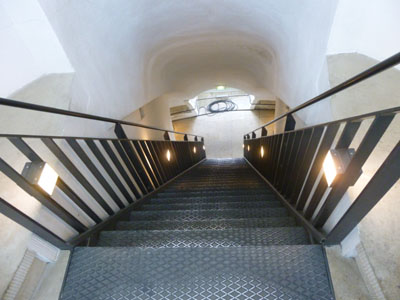
At the top of these stairs, I was actually standing in a room almost in the exact center of the top of the dome. If you are confused as to the structure of the dome, don't be. It's pretty simple. If you stand in the church and look up through the oculus, what you will see is not the underside of the actual roof of the church, but the underside of the inner dome- all domes being constructed like your house with an attic. The ceiling of your top-floor room isn't actually the roof; there is an attic under the roof and above that ceiling. I was standing in the equivalent of the dome's "attic", and right at the bottom of the very last stairs- a spiral staircase leading up to the door out to the open (but roofed) observation platform- about 200 feet above the plaza.
I immediately began wandering around the observation platform, which was actually a narrow, circular walkway around the very top of the dome below. Perhaps to orient you to the platform, you could watch one or both of the movies I made. They are similar, and in both cases the wind noise was so obtrusive that I have eliminated the sound altogether:
|
|
Now for the pictures. As usual, I tried to document the views in every direction, taking a picture from all four quadrants of the observation area. As there were columns in the way, it was not possible to attempt a 360° movie, nor would a similar panorama be possible. I did find that groups of the individual pictures I took could actually be stitched together into more panoramic images, so that is what I have done where possible. Take one of the best views, for example, in the scrollable window below; it looks north across the Elbe:
At left is the spire of the Catholic Cathedral at Schlossplatz, and you can see the bridge from that plaza leading across the Elbe. You can see the classically-designed government building seen earlier across the river, and spread across the front of the panorama is the Academy of Fine Arts and the "Lemon Squeezer" dome of that complex at the right. Scroll the image to the right, and you'll see the Elbe Bridge from Carolplatz on the far side of the river coming across past the New Synagogue. The large red-roofed building at right is the Albertinium Museum.
|
At the right in the image is the Elbe River bridge from the Schlossplatz, and you can see both the spire of the Catholic Cathedral as well as the tower of the Courthouse.
To the left is the tower of Dresden Castle, and you can see most of that complex.
In the background is the Semperoper (the opera house) and in the nearground you can see most of the Furstenzug porcelain mural along Augustplatz. South of Dresden Castle, at the extreme left in the image, is the Zwinger Palace, which was our first stop earlier this morning.
Here are two of my pictures that aren't panoramas. The right-hand image looks directly below the church to the north, and you can pick out the red awnings of the Edelweiss Restaurant where we had lunch earlier. In the left-hand picture, you are looking southwest down into the Neumarkt and one of the last buildings around that square that is being restored.
|
|
The only direction I haven't shown you is basically south, so let's have a look.
|
The tower at the right in the background is part of the Holy Cross Church, and its tower is about a hundred feet higher than the one I am standing on. The other tower belongs to the Dresden Town Hall.
We've come full circle in the views from the dome, as the Albertinium would be just outside this view at the left.
As you will probably agree, the views from the dome were well worth the climb, and I enjoyed walking around outside here at the top. However, there is one more view to show you, and it was the hardest one for me to get.
|
That's why it was hard for me to get this shot of Fred waiting for me at the Martin Luther statue; he is the figure on the raised platform at the lower left corner of the sculpture. (I know this, not because I could see him clearly, but because that's where he was when I returned to him fifteen minutes hence.)
To get this shot, I actually had to hold my camera out over the railing and point it by estimating, it was impossible for me to lean over the railing and look through the viewfinder to get the shot. (At that, I had to take three pictures before I got this one pointed in just the right direction.)
I left the dome via a second spiral stairway; the route down (at least part of it) was different from the route up. At the bottom of this staircase I found myself on another sloping ramp heading down. As it turned out, this ramp brought me to the base of the same stairs that I'd gone up earlier; you can see a couple of guys heading up to the dome. The routes are one-way because trying to pass someone on a spiral stair is next to impossible.
|
|
(Mouseover Image Above for Video Controls) |
Our Return Trip to Berlin
|
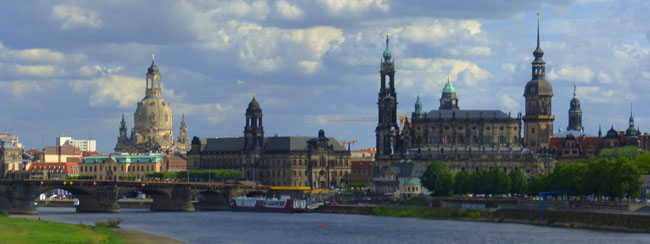
I also took a panoramic view as the bus slowly crossed the bridge (no mean feat, you should know). We were quite a bit further down the river, leaving Dresden, so this is a different view:

Our trip back to Berlin was uneventful; the lack of good light meant that we didn't take very many pictures, and almost all the ones we did take were just of open countryside. Our tour guide did point out to us, as we came into Berlin from the south, that we were passing the now decommissioned Templehof airport. The whole thing is now a park. The buildings aren't used for much of anything, but the runways have been torn up and the entire area is now a huge open space, suitable for kite flying, toy airplanes and drones.
We got back to the Zoo Garden Station about 7PM, and walked back to the hotel very satisfied and pleased with the day's outing. We had our usual relaxing drink in the Hotel Am Steinplatz courtyard and then went to dinner at the restaurant next door to the hotel.
You can use the links below to continue to another photo album page.
 |
May 25, 2017: Potsdam and a Spree River Cruise |
 |
May 23, 2017: A Day on Museum Island |
 |
Return to the Index for Our Visit to Berlin |